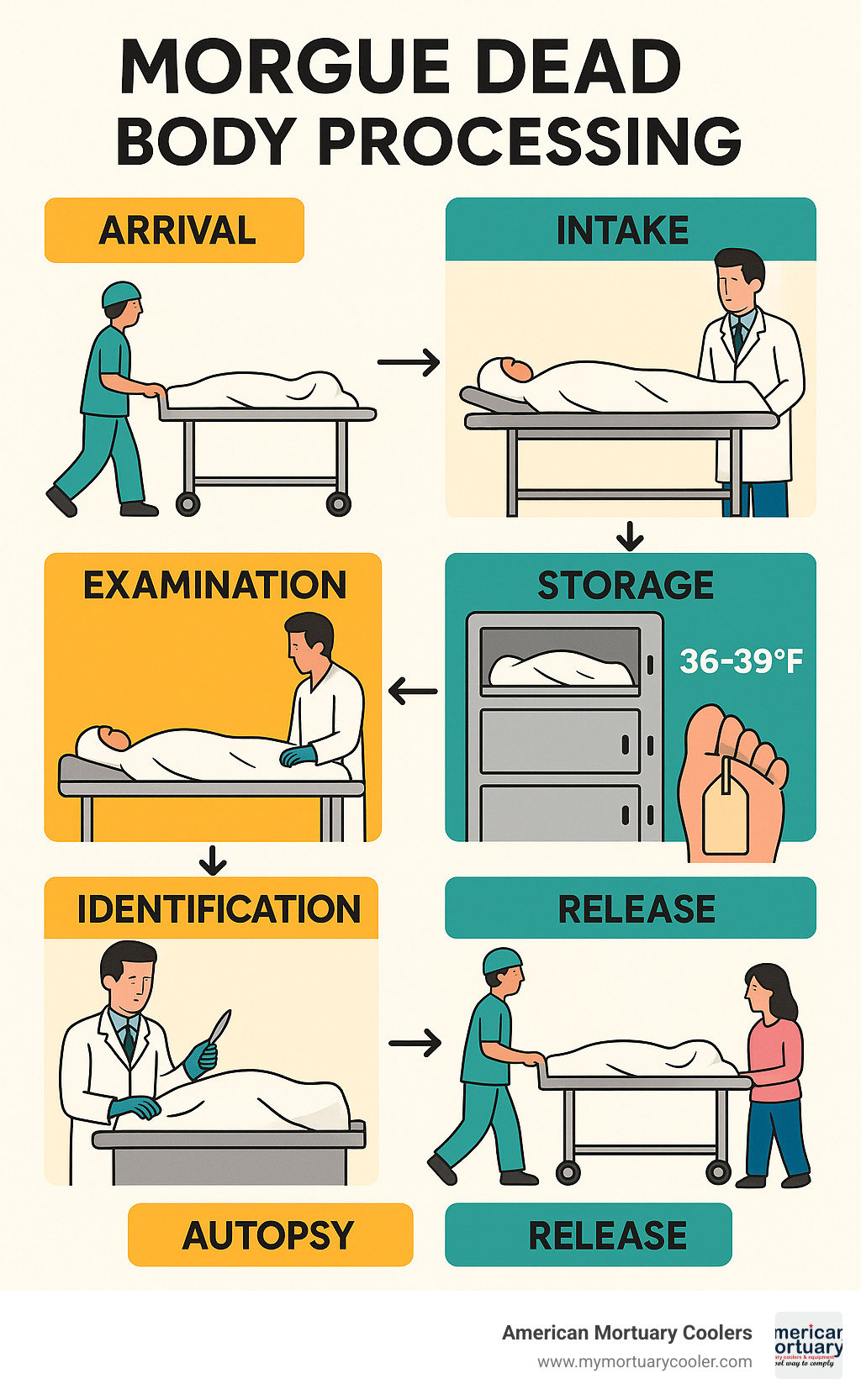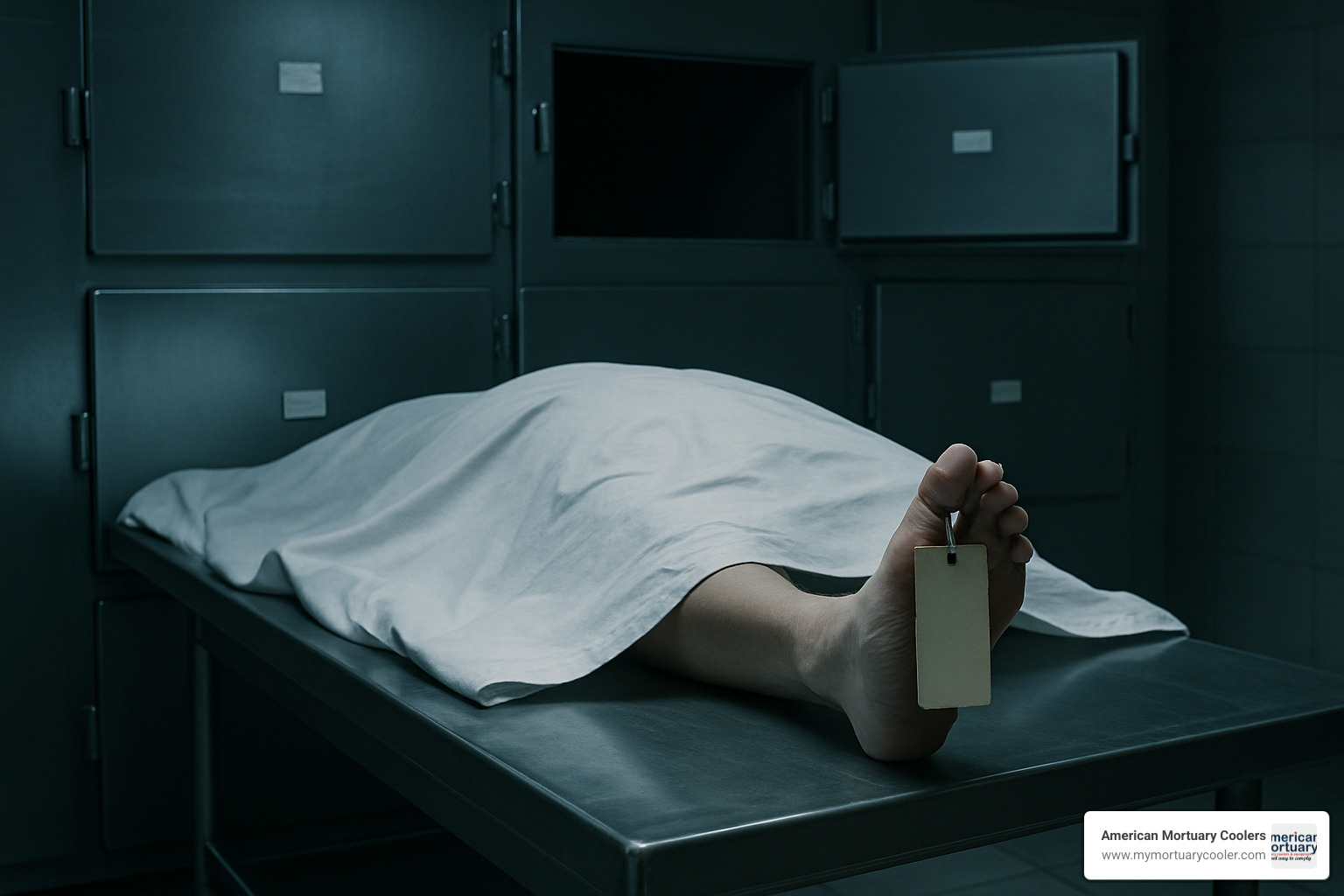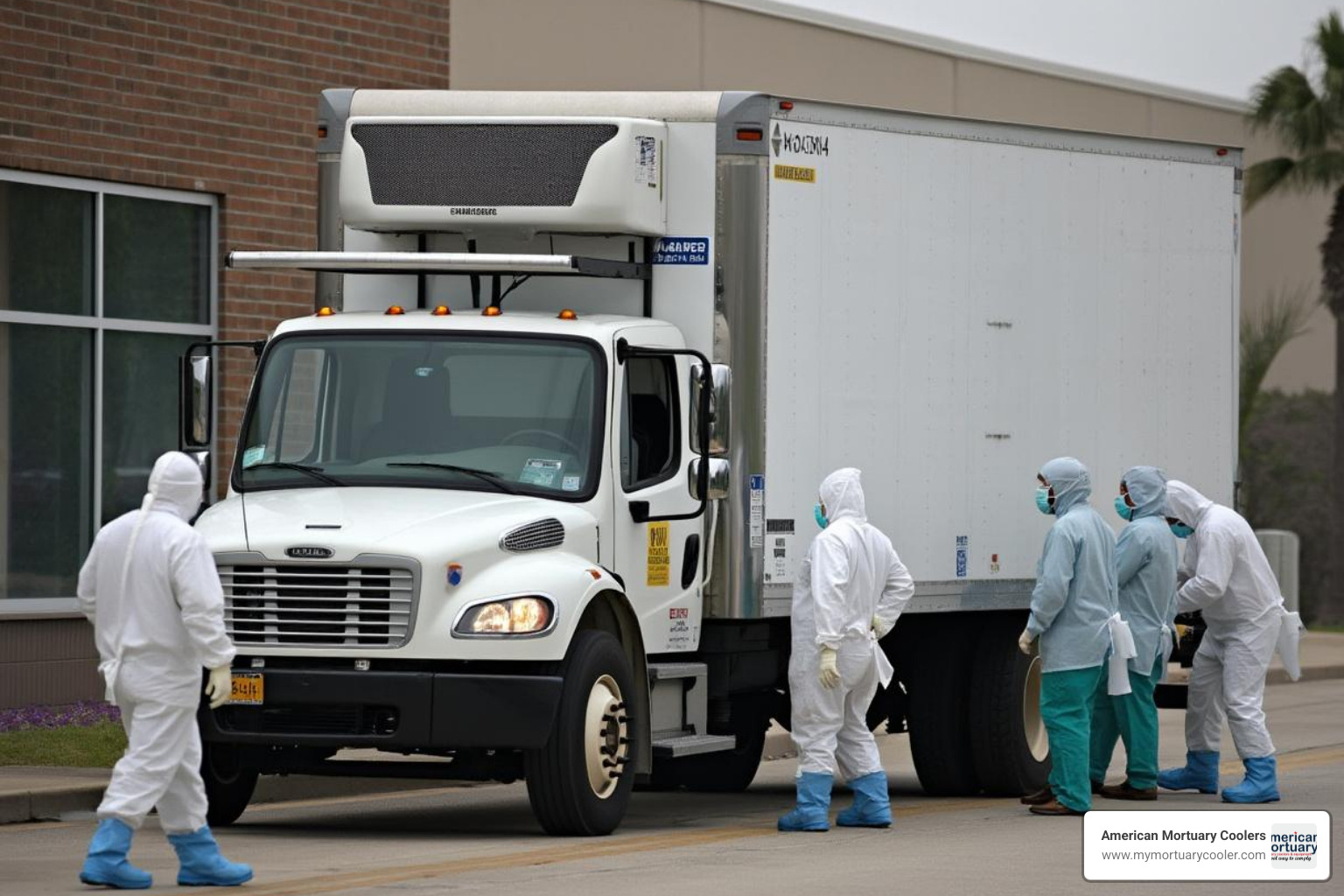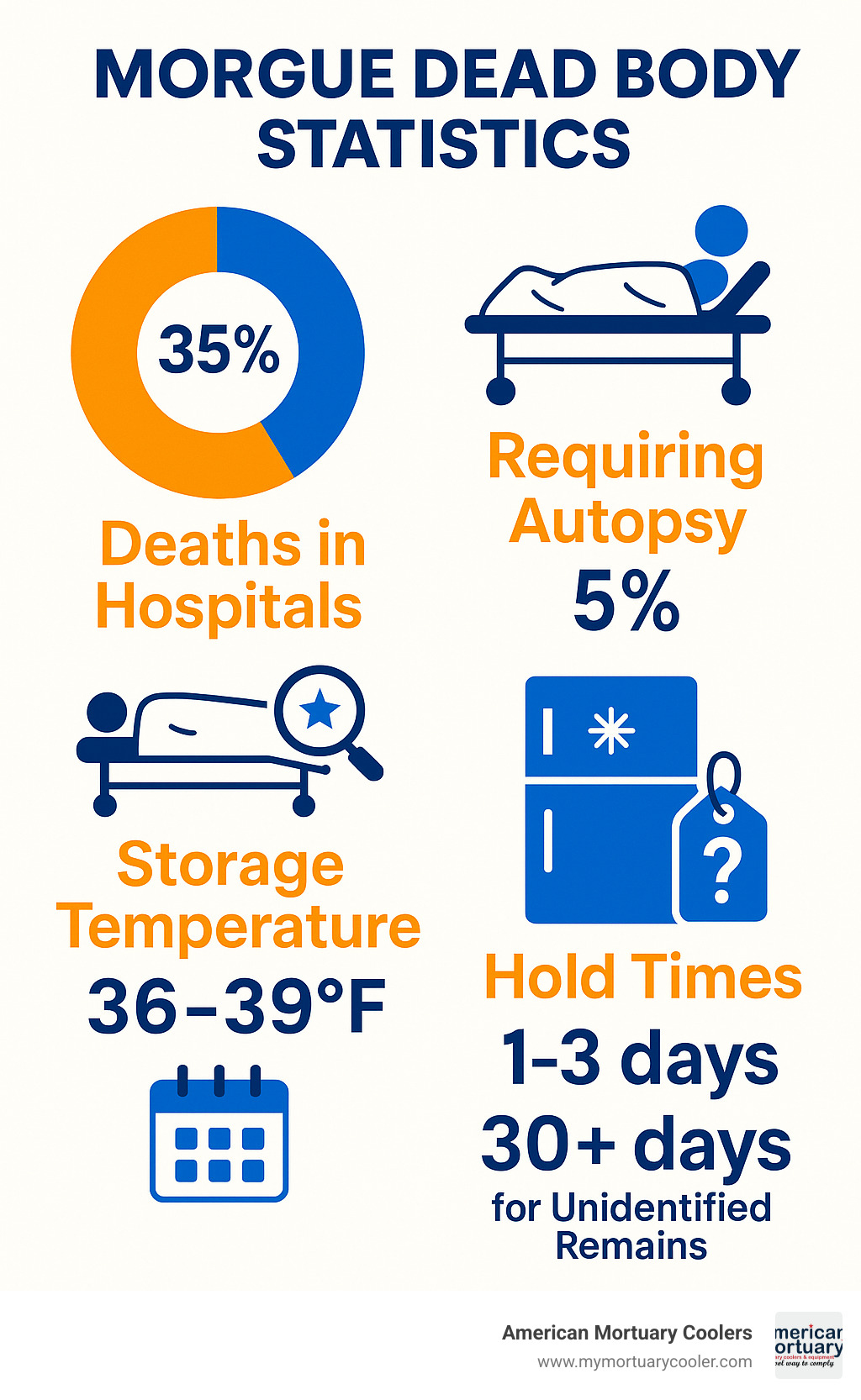Why Understanding Morgue Dead Body Procedures Matters
Morgue dead body handling is a critical aspect of healthcare and forensic operations that requires precise protocols, proper equipment, and respectful care. Whether you're managing a hospital morgue, funeral home, or forensic facility, understanding how bodies are processed, stored, and released is essential for maintaining dignity while ensuring legal compliance.
Key Facts About Morgue Dead Body Management:
- Primary Purpose: Temporary storage of deceased individuals awaiting identification, autopsy, or release to families
- Storage Temperature: Bodies are typically kept at 36°F-39°F to slow decomposition
- Identification Methods: Toe tags, digital records, fingerprints, and dental records
- Typical Hold Time: Most bodies are held 1-3 days, though unidentified remains may stay 30+ days
- Staff Involved: Medical examiners, coroners, pathologists, and mortuary assistants
The morgue serves as both a temporary storage facility and an investigative space where medical professionals determine cause of death. According to research, approximately 35% of deaths occur in hospitals and are taken to morgues, with about 5% of hospital deaths requiring autopsy. Bodies are wrapped in plastic bags, placed on metal trays, and stored in refrigerated units to preserve them for examination and family viewing.
Modern morgues use specialized equipment including mortuary coolers, body lifts, and identification systems to ensure proper handling. The process involves careful documentation, chain of custody procedures, and coordination between medical staff, families, and funeral homes to maintain both legal requirements and respectful care.
As specialists at American Mortuary Coolers, we've spent years helping facilities across the country implement proper morgue dead body storage solutions. Our experience with custom cooling systems has shown us how critical proper equipment is for maintaining dignity and operational efficiency in these sensitive environments.

Handy morgue dead body terms:
Inside a Morgue Dead Body Journey
Every morgue dead body follows a carefully planned path from arrival to final release. This journey involves multiple checkpoints, detailed documentation, and respectful handling at every step. Understanding this process helps families know what to expect and ensures facilities maintain proper protocols.
When a body first arrives at the morgue, the chain of custody begins immediately. Staff members document exactly when the body arrived, who transported it, and any circumstances surrounding the death. This paperwork becomes part of a permanent record that follows the body throughout its stay.
The initial external examination happens right away. Medical staff look for obvious injuries, identifying marks like tattoos or scars, and any unusual circumstances. This preliminary assessment helps determine what type of examination or autopsy might be needed.
Toe-tagging is probably the most well-known part of morgue operations. Each body gets a unique identification tag with important details like the case number, arrival date, and preliminary identification information. Many modern facilities now use digital ID systems alongside traditional toe tags, creating electronic records that link directly to the physical remains.
Bodies are then moved to their appropriate destination. Those requiring autopsy go to specialized suites equipped with pathology tools and examination tables. For routine storage, bodies are placed in refrigerated units kept at a steady 36°F to 39°F. Some facilities also have negative-temperature freezers operating between -10°C to -50°C for long-term storage or special forensic cases.
The release protocols depend entirely on the type of death. Hospital morgues typically handle routine deaths quickly, while forensic facilities may need to hold bodies much longer during investigations.
| Hospital Morgue | Forensic Morgue |
|---|---|
| Routine deaths from medical causes | Suspicious, violent, or unexplained deaths |
| 1-3 day average hold time | Extended hold times for investigation |
| Basic external examination | Comprehensive autopsy procedures |
| Family notification priority | Legal investigation priority |
| Standard refrigeration (36-39°F) | May require freezing capabilities |
Understanding morgue operations helps everyone involved. For detailed technical information, check out this Scientific research on morgue functions. Our comprehensive guide Inside Morgue Drawers: How Cadavers Are Actually Stored explains proper storage protocols in detail.
Arrival and Intake of a Morgue Dead Body
The arrival process starts with a careful gurney transfer from the transport vehicle. Staff immediately secure any personal belongings, creating a detailed personal effects log that includes jewelry, clothing, identification documents, and other items. This inventory becomes part of the permanent record and ensures families get their loved one's belongings back.
Modern morgues often use fingerprint scanning technology to create digital identification records. If there's any question about identity, staff may request dental records or collect DNA swabs for genetic confirmation. Every single step gets documented with timestamps and staff signatures to maintain the chain of custody.

The intake process also includes photographing the body from multiple angles. Staff note any distinguishing features, tattoos, scars, or medical devices like pacemakers. This visual documentation serves both identification and legal purposes, creating a permanent record of exactly how the body looked when it arrived.
From Autopsy to Release of the Morgue Dead Body
When an autopsy is required, the pathologist performs a systematic examination. This typically includes the characteristic Y-incision across the chest and abdomen. Tissue samples get collected for toxicology testing, which can take several days to complete. The pathologist documents all findings in a comprehensive cause-of-death report that becomes part of the official legal record.
After the examination is complete, the body is carefully sutured and thoroughly washed. Families may choose embalming for preservation during funeral services, though this isn't always necessary depending on timing and family preferences.
The final step involves coordinating with the funeral home for pickup. Staff ensure all paperwork is complete and the body is properly prepared for transport. This handoff marks the end of the morgue's responsibility and the beginning of the funeral home's care.
Throughout this entire process, maintaining dignity and respect remains the top priority. Every morgue dead body receives the same careful attention, regardless of circumstances. This systematic approach ensures families can trust that their loved ones are being handled with the utmost care and professionalism.
Viewing, Identification & Family Interaction
The hardest part of any morgue's work isn't the medical procedures or paperwork—it's helping families through the most difficult moments of their lives. When a morgue dead body arrives, staff know that somewhere, people are grieving and need answers, closure, and dignity for their loved one.
Next-of-kin notification requires extraordinary care and compassion. Trained staff members deliver devastating news with sensitivity, understanding that how families first learn about morgue procedures can shape their entire experience. Many facilities work closely with chaplain services to provide spiritual support during these overwhelming moments.
Private viewing rooms offer families a peaceful space to say their final goodbyes. These rooms are designed to feel more like comfortable living spaces than clinical facilities, with soft lighting and seating areas where multiple family members can gather. The goal is creating an environment where grief can be processed naturally, away from the operational aspects of the morgue.
Positive identification serves as both a legal requirement and an essential step in family healing. Sometimes this involves direct viewing by family members, though staff are trained to prepare families for what they'll see and provide support throughout the process. When direct viewing isn't possible or advisable, photo line-ups or comparison of dental records can provide the certainty families need.
In complex cases, DNA analysis becomes the definitive identification method, though results can take several days or weeks. During this waiting period, morgue staff maintain regular communication with families, explaining the process and providing realistic timelines.
Cultural and religious considerations add another layer of complexity to morgue operations. Different faiths have specific requirements for how deceased individuals should be handled, positioned, or prepared. Islamic traditions may require the body to face Mecca, while Jewish customs often prohibit embalming. Hindu families might request specific rituals before cremation.
Morgue staff receive training on various cultural rituals and work with religious leaders to accommodate these needs within operational constraints. This might mean adjusting storage procedures, allowing extended family access, or coordinating timing for religious observances.
Grief support services help families steer not just their emotional needs, but also the practical requirements of death certificates, autopsy results, and funeral arrangements. Social workers or counselors often work alongside morgue staff to ensure families understand their options and feel supported throughout the process.
For families dealing with unexpected loss, understanding proper storage becomes important. Our detailed guide Everything You Need to Know About Body Storage in Morgue Fridges explains how loved ones are cared for during this difficult time. The scope of this challenge becomes clear when reviewing Scientific research on U.S. death statistics, which shows the volume of families morgues serve each year.
Legal & Ethical Considerations
Behind every compassionate interaction lies a framework of strict legal and ethical requirements that protect both families and facilities. Consent forms must be signed before any autopsy procedures, with clear documentation showing who has legal authority to make decisions for the deceased. This can become complicated when families disagree or when legal next-of-kin differs from emotional connections.
Autopsy authorization involves explaining the procedure, what information it will provide, and how long results might take. Families often struggle with this decision, especially when they're already grieving. Staff must balance providing enough information for informed consent while being sensitive to emotional states.
Privacy laws create a protective barrier around the deceased, ensuring that information and images aren't shared inappropriately while still allowing necessary medical and legal procedures. This means carefully controlling who has access to viewing rooms, autopsy results, and identification records.
Chain-of-evidence protocols become critical in cases where legal proceedings might follow. Every person who handles the body, every test performed, and every document created must be properly logged and secured. This documentation protects the integrity of potential criminal cases while ensuring families can trust the results they receive.
Unclaimed remains present some of the most challenging ethical situations morgues face. Most jurisdictions require at least a 30-day hold period for unidentified bodies, during which staff work tirelessly to locate family members through missing person databases, social media, and community outreach. Remarkably, only about 1% of deaths remain unclaimed after this period.
When bodies cannot be identified or claimed, the responsibility shifts to hospitals or state agencies to arrange appropriate disposition. This usually means burial or cremation at public expense, but even these cases are handled with dignity and respect. Some facilities hold annual memorial services for unclaimed individuals, ensuring that every person who passes through their care is remembered and honored.
Safety, Technology & Mass-Fatality Response
Modern morgue operations prioritize safety through comprehensive PPE standards, proper ventilation systems, and strict biohazard protocols. Staff wear protective equipment including gloves, gowns, masks, and eye protection when handling bodies or conducting examinations.
During mass-fatality events like pandemics or disasters, morgues may quickly exceed capacity. The COVID-19 pandemic demonstrated the need for overflow solutions, with cities deploying refrigerated trucks and converting ice rinks into temporary morgue facilities. These emergency measures help maintain dignified care even during overwhelming circumstances.
The Disaster Victim Identification (DVI) protocol, developed by Interpol, provides a systematic approach to mass casualty events. This five-phase process includes scene recovery, mortuary processing, antemortem data collection, reconciliation, and debriefing. RFID tagging and AI facial recognition technologies are increasingly used to streamline identification in these challenging situations.

For detailed comparisons of storage options, review Morgue Freezer vs. Morgue Refrigerator: Essential Insights.
Innovations Improving Morgue Dead Body Care
Technology continues to improve morgue operations and morgue dead body care. Remote temperature monitoring systems alert staff to any cooling system failures, preventing decomposition and maintaining proper storage conditions. Cloud-based documentation systems create secure, accessible records that can be shared between facilities and agencies.
Mobile body boxes provide flexible storage solutions, particularly useful as backup or overflow capacity. These units can store one to six bodies depending on size and operate on standard electrical outlets, making them practical for smaller facilities or emergency situations.
Ergonomic lifts and handling equipment reduce staff injury while ensuring dignified body movement. At American Mortuary Coolers, we've seen how proper lifting equipment serves as a "second attendant," reducing physical strain and improving operational efficiency.
Learn more about cooling innovations in our guide Chilling Facts About Mortuary Coolers.

Frequently Asked Questions about Morgues & Dead Bodies
When families face the loss of a loved one, questions about morgue procedures often arise during an already difficult time. Understanding these processes can help ease concerns and provide clarity during grief.
How long can a body stay in a morgue?
The answer depends on several circumstances surrounding the death and the facility's protocols. Routine hospital deaths typically involve the shortest stays, with most bodies released to funeral homes within 24 hours once paperwork is completed and families make arrangements.
When an autopsy is required, the timeline extends to 2-3 days while medical examiners complete their examinations and toxicology testing. The pathologist needs adequate time to conduct thorough investigations and prepare detailed reports.
Unidentified bodies face much longer stays, with facilities required to hold them for at least 30 days while making reasonable efforts to locate next of kin. Fortunately, only about 1% of deaths remain unclaimed after this mandatory waiting period.
From a preservation standpoint, morgue dead body storage at proper refrigeration temperatures of 36°F-39°F can maintain remains for several weeks without significant decomposition. When forensic investigations require extended storage, negative temperature systems operating at -10°C to -50°C can preserve bodies for much longer periods.
When is an autopsy mandatory?
Autopsy requirements vary by state and local jurisdiction, but certain circumstances consistently trigger mandatory examinations. Suspicious deaths always require autopsy, including any death involving potential criminal activity or unexplained circumstances.
Deaths without medical attendance often mandate autopsy, particularly when someone dies at home without recent medical care or known terminal illness. Workplace accidents, vehicle fatalities, and deaths involving medical devices also typically require examination.
About 10% of all deaths require autopsy nationwide, with 5% of hospital deaths involving the procedure. Medical examiners or coroners make these determinations based on the specific circumstances surrounding each death.
Even when not legally required, families may request autopsy for medical or personal reasons. This voluntary autopsy can provide answers about genetic conditions, clarify cause of death, or address family concerns, though it typically involves additional costs not covered by insurance.
What happens if a body is never claimed?
Unclaimed bodies follow specific legal procedures designed to ensure dignified treatment even when families cannot be located. After the mandatory hold period, hospitals or state agencies must demonstrate they made reasonable efforts to find next of kin through obituaries, social media searches, and contact with known associates.
State and local regulations govern the specific procedures, but the goal remains consistent: providing respectful disposition for every individual. Most unclaimed remains are buried or cremated at public expense, with basic services that maintain dignity while managing costs.
Some medical schools accept body donations when appropriate consent can be obtained, allowing unclaimed remains to contribute to medical education. This option requires specific legal procedures and isn't available in all jurisdictions.
The process typically involves social workers or patient advocates who coordinate with various agencies to exhaust all identification possibilities before proceeding with final disposition. Even in these difficult circumstances, the focus remains on treating every morgue dead body with the respect and dignity every person deserves.
Conclusion & Next Steps
Understanding morgue dead body procedures is about more than just following protocols—it's about honoring the dignity of those who have passed while providing comfort to grieving families. Every step in the process, from that first careful arrival documentation to the final release, requires both technical precision and human compassion.
The journey we've explored together shows how critical proper equipment becomes in this sensitive work. When temperature control fails or storage systems break down, the consequences affect not just operations but the very dignity we're working to preserve. That's why investing in reliable, purpose-built cooling solutions isn't just a business decision—it's a commitment to the families you serve.
At American Mortuary Coolers, we've built our reputation on understanding exactly what's at stake in morgue dead body care. Our custom cooling solutions aren't just about maintaining the right temperature—they're about giving you the confidence that comes from knowing your equipment won't let you down when families need you most.
Based right here in Tennessee, we've been designing and delivering custom mortuary coolers across all 48 contiguous states for years. We know that every facility has unique needs, whether you're managing a small hospital morgue or a large forensic facility. That's why we don't believe in one-size-fits-all solutions.
Our durable systems are built to handle the demands of daily operations while maintaining the precise temperature control that proper preservation requires. When you're dealing with the unexpected—whether it's a sudden influx of cases or emergency situations—you need equipment that responds reliably, every single time.
Whether you're planning a new facility, upgrading aging equipment, or need emergency backup cooling, we understand the critical importance of getting it right. Our team works with you to design solutions that fit your space, your workflow, and your budget while never compromising on the quality that dignified care demands.
For a deeper dive into your options, our comprehensive guide The Essential Guide to Morgue Fridges: Importance, Benefits, and Features covers everything from basic refrigeration needs to advanced features that can streamline your operations.
Ready to discuss how our custom solutions can support your facility's important work? Contact us today to explore how American Mortuary Coolers can help you provide the dignified care families deserve and the reliable performance your staff needs to do their best work, day after day.


















